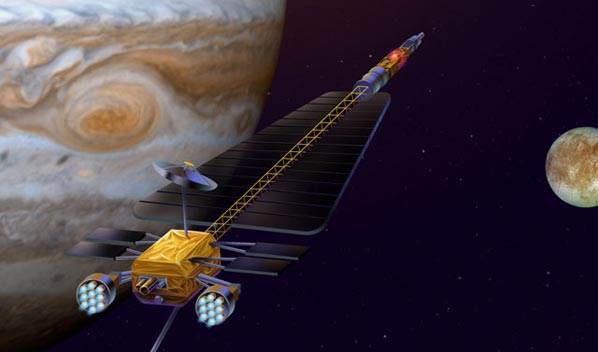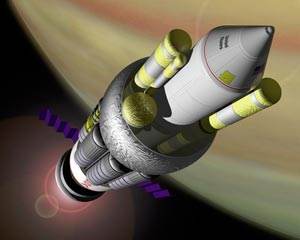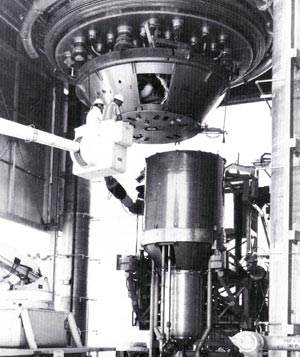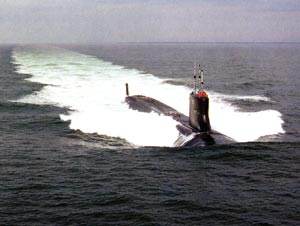
Has the time finally come for nuclear-powered spacecraft?
By Leonard David
Update: Both the Prometheus program and the Jupiter Icy Moons Orbiter (JIMO) were cancelled in late 2005.
For NASA, it had been a long time in coming—permission to use the “N” word: nuclear power in space. In many ways, it has been the political, financial and technological third rail of space exploration—too hot of an issue to handle easily … and radioactive to boot.
In 2003, NASA’s Prometheus program was established to develop technology and conduct advanced studies in the areas of radioisotope power system and nuclear power and propulsion. One intended outcome for this work is the conception of the first reactor powered spacecraft. Doing so will be essential for long-duration space missions and—as then NASA administrator, Sean O’Keefe, described in kick-starting the program—a way to battle the “distance and time dilemma” that now inhibits any space exploration and discovery agenda for the 21st century.
To prove his point, O’Keefe more than once retrofired his way back to America’s first piloted orbital flight in 1962. Speeds have not changed much since John Glenn’s Friendship 7 mission, he suggested, saying that “this is not good enough for space exploration.”
The Prometheus space nuclear power agenda is a threefold quest: nuclear electric power, surface power hardware for Moon and Mars human outposts, and nuclear thermal propulsion.
To advocates, spacecraft powered by nuclear fission reactor is must-have high-technology. It’s perfect for planet hopping and pushing large masses of cargo outward from Earth. But there are those who question the logic behind nuclear space power and propulsion. They see safety and reliability woes, and even a hidden agenda.
Project Orion: The kick inside
The quest for harnessing nuclear energy to carry out deep-diving assaults into space has a long history.
In the 1950s into the 1960s, classified work was conducted to study a pulsed nuclear fission propulsion system. (Some of it remains classified today.) Tagged Project Orion, the idea was to expel nuclear bombs from the back end of a large passenger-carrying space vehicle. Each specially shaped bomb blast would kick against a shock absorber-like system that kept the crew safe while pushing the spacecraft forward.

Those working on Orion wrestled with many engineering issues. A scale model of the Orion propulsion idea even flew successfully. Using chemical explosives, the mini test model flew for 23 seconds, to nearly 200 feet from a makeshift launch area in the Point Loma area of San Diego, California. Nevertheless, the test shot was a far cry from a 40,000-ton, crew-carrying spaceship propelled by nuclear bombs screaming across interplanetary distances, as well as setting the stage for eventual stellar jaunts.
Orion’s promising future was abandoned due to issues of public safety, as well as the prospect of fallout resulting from a ground-launched spaceship. An international nuclear weapon test ban on detonating such bombs in space also put an end to Orion.
Physicist Freeman Dyson, who worked on the project, recalled the end of his “romantic days” of working on Orion. After the effort was killed there was “no more brave talk of manned expeditions to Mars by 1965, and of sampling the rings of Saturn by 1970,” he noted.
Dyson has a speculative question: If the government had continued its support of Orion, would a cheap and rapid transportation system now be up and operating all over the Solar System? “Or are we lucky to have our dreams intact?”
NASA: Lost its NERVA
There are three different categories of nuclear technology for space power and propulsion: nuclear radioisotope systems for generating electricity; closed-cycle nuclear reactors to generate electricity; and open-cycle nuclear thermal reactors that heat a propellant directly to produce rocket thrust.
Historically, NASA has repeatedly danced with nuclear rocketry. With the space program on full-throttle in the 1960s, the rover/Nuclear Engine for Rocket Vehicle Application (NERVA) was being researched by NASA and the then U.S. Atomic Energy Commission (AEC). After all, what better way to propel the projected human mission to Mars, given a targeted 1981 send-off?
A series of reactor tests—KIWI-A, KIWI-B, Phoebus, Pewee and the Nuclear Furnace—were performed. Government and industry teams studied high-temperature nuclear fuels. Long-life fuel elements were appraised to understand the basics of nuclear rocket technology. Tests were handled at the Nuclear Rocket Development Station at the AEC’s Nevada test site in Jackass Flats, Nevada, some 100 miles west of Las Vegas.

But success was short-lived. In the late 1960s and early 1970s, U.S. President Richard Nixon nixed NASA and NERVA funding dramatically. Arguably, those cutbacks were spurred by a lack of public interest in human spaceflight. Eventually, NERVA lost its funding and the project was scuttled in 1973.
A resurgence of U.S. interest in orbiting large nuclear reactors in space occurred during the Strategic Defense Initiative (SDI), better remembered as the so-called Ronald Reagan “Star Wars” missile-defense era. When SDI dissipated, reactors energizing orbital battle stations also evaporated. Shelved in the process was multi-agency reactor development (including NASA) under the Space Power 100 (SP-100) program.
Plutonium-powered Projects
Over the decades, numbers of human, as well as robotic space projects have been dispatched that haul Radioisotope Thermoelectric Generators, or RTGs. These are not nuclear reactors and don’t use fission nor fusion processes to produce energy. Instead, they provide power through the natural radioactive decay of plutonium—mostly Pu-238, a non-weapons-grade isotope. The heat generated by this process is transformed into electricity by solid-state thermoelectric converters.
Apollo lunar expedition sojourns used RTGs, as did the Viking Mars landers. RTGs made possible the Voyager explorations of Jupiter, Saturn, Uranus and Neptune, as well as the Pioneer missions to Jupiter and Saturn. The Galileo mission to Jupiter utilized RTG power sources. So does the international Ulysses mission that’s probing the polar regions of the Sun.
At present, Cassini’s exploration of Saturn and its neighborhood of Moons is made possible by a trio of onboard RTGs. Next year’s liftoff of New Horizons, aimed at faraway Pluto and the Kuiper belt is also RTG powered. Also, NASA’s wheeled Mars science laboratory is to be outfitted with more efficient RTG-like hardware.
In past years, plutonium-based thermal generators used on space missions have been met by launch-site protests. Environmental groups have voiced worry that, in the event of an accident, the public could be on the end of widespread radiation dispersion.
NASA and the U.S. Department of Energy underscore the fact that RTGs enable spacecraft to operate at significant distances from the Sun or in other areas where solar power systems would not be feasible. They remain unmatched for power output, reliability and durability by any other power source for missions to the outer solar system, and are very safe.
Leftover particles
Despite the suggested track record, RTGs have been involved in several launch failures. Accidental reentries through the Earth’s atmosphere have also occurred. “None of these accidents have caused measurable health effects in the human population, though some environmental contamination has occurred,” explains a NASA RTG fact sheet.
Several nuclear reactors hurled into Earth orbit by the former Soviet Union have encountered trouble. In 1978, for example, Cosmos 954 failed to enter into a nuclear-safe storage orbit as planned. Nuclear materials survived the fall through the atmosphere and spread over a wide area of Canada’s Northwest Territory. A search and recovery effort coordinated by the Canadian government with U.S. help was undertaken after this accident. Since the cleanup operations, no detectable contamination has been found in samples of air, water or food supplies.
Then there’s the case of Russia’s1996 mission to Mars.
That Mars-bound spacecraft failed to achieve proper orbit, either crashing into ocean waters or, some still contend, dumping its plutonium canisters into South American mountains.
Meanwhile, up in Earth orbit, thousands of frozen bits of still-radioactive nuclear reactor coolant are resident in space. They are leftover particles that dribbled out from a number of aged Russian radar snooping satellites.
Run silent, run deep
Under the Prometheus rubric, NASA sealed a deal in March 2004 with the Department of Energy’s National Nuclear Security Administration—Naval Reactors. That collaboration is to result in a rugged, compact, long-lived space-rated reactor. Naval Reactors has signed on the dotted line to develop, design, deliver, and provide operational support of civilian space nuclear reactors.
Naval Reactors has compiled an unparalleled record of success. They are responsible for more than 100 operating nuclear reactors. One count has it that nuclear-powered warships visit some 150 ports around the globe. They have 50-plus years of practical experience.

The mission of Naval Reactors is to provide the Navy with safe, long-lived, militarily-effective nuclear propulsion plants in keeping with the nation’s defense requirements, and to ensure their continued safe and reliable operation. An autonomous space reactor, on the other hand, faces unattended operation, communication delays, among other constraints.
So on the surface, and even below it, the seas of Earth and the depths of outer space aren’t quite on the same wavelength. Yet, the symbolism of Naval Reactors enabling vessels to cruise the oceans, as well as sailing through the ocean of space is appealing.
Such a space reactor system would provide substantially more electrical power than what was previously available for past missions. This would greatly enhance the capability of ion-drive propulsion, the number and variety of scientific instruments on a spacecraft, the rate of data transmission, and the ability to stage extensive orbital maneuvers. Moving forward on Prometheus would showcase that nuclear reactors can operate safely and reliably in space.
NASA initially scoped out as a “flagship” mission for Prometheus the Jupiter Icy Moons Orbiter (JIMO) spacecraft. The ambitious mission would orbit and explore three of Jupiter’s planet-sized Moons—Callisto, Ganymede and Europa—which may have vast oceans beneath their icy surfaces. A nuclear reactor would enable the mission.
In September 2004, NASA’s Jet Propulsion Laboratory selected Northrop Grumman Space Technology in Redondo Beach, California as the contractor for co-designing the proposed Prometheus JIMO spacecraft.
Late last year, however, NASA began reviewing a list of fission-powered missions that could pre-empt JIMO. It was already in date-slip mode, being eyed for space travel no sooner than 2015. Less demanding and less costly, but more near-term, Prometheus missions are now being reviewed. Among them is a lunar geophysical orbiter that in extended mission mode could serve as a telecommunications asset for future lunar missions. A Near Earth Object (NEO) asteroid mission is under assessment too, involving stopovers at multiple objects, perhaps landing hardware on a NEO to assess the ability to modify the trajectory of a celestial body.
Beyond the edge of sunshine
Prometheus has already earned the attention of protest groups. “The notion of Project Prometheus to us means that NASA is rocketing backwards to the days of NERVA and Orion,” says Bruce Gagnon, coordinator of Global Network Against Weapons & Nuclear Power in Space, an organization based in Brunswick, Maine. “These previous manifestations of the nuclear rocket were shut down because the political powers at the time realized that they were an environmental danger to all of us,” Gagnon says.
For Gagnon and his group, the expanded use of nuclear power in space means more lab contamination as the development process takes place, a greater risk of launch accidents, and the possibility of nuclear devices falling back to Earth. Adding to those concerns, he says, is the under-the-table deal-making going on.
“We’ve long maintained that in this day of NASA ‘dual use’ space missions, there is a military application for the nuclear rocket,” says Gagnon. “We are clear that NASA’s Project Prometheus is a Trojan horse. We understand that the agenda is to move nuclear power into space for military purposes … and always has been.”
There are alternatives to nuclear power in space, Gagnon suggests. He points to the prospect that solar arrays of the future won’t have to rely on the Sun. Lasers can beam photons to solar arrays. Indeed, if a powerful enough laser was used, energy-providing solar arrays could operate beyond the edge of sunshine.
That’s a solar flare for Gagnon. “If NASA and the Department of Energy were to stop wasting money on nuclear power they could invest in new technologies for space propulsion that would be safe, clean and politically acceptable,” he concludes.
Survival of our species
Having a far different outlook is Bruce Behrhorst, president of Nuclear Space Technology Institute, Inc. He runs the NuclearSpace.com website. Its short and sweet mission: “To promote the use of nuclear power in space to further enhance the manned exploration of our Solar System.”
“There is no other technology in the near term that can be manipulated to service human beings in outer space other than nuclear energy, if at least to insure the survival of our species in the heavens,” Behrhorst believes. “Our technological prowess and space exploration requires the use of dynamic, high density energy systems to realistically transport humans and robotica in a safe and efficient mode.”
Behrhost sees space nuclear power as opening the window to other realistic methods to affect the space and time frame metric, thus “providing insight into the micro universe for the practicality of bridging much of the ultimate macro universe.”
Similar in view is James Dewar, a former nuclear affairs expert in the Department of Energy. In his book, To the End of the Solar System: The Story of the Nuclear Rocket [University Press of Kentucky, 2003], he stresses that chemically propelled rockets can lift less than five percent of their takeoff weight into orbit. That fact is a prescription for a stay-at-home, highly limited space program.
Dewar sees nuclear-powered rockets, however, as offering far superior thrusting power and speed. To date, the nuclear rocket story has been scarred by political battles over the space program’s future, involving U.S. presidents Dwight Eisenhower, John F. Kennedy, Lyndon Johnson and Richard Nixon. He maintains that only by reestablishing a nuclear rocket project can the nation have a space program worthy of the 21st century, one that makes reality of the hopes and dreams of science fiction.
Just like those projects of the past, NASA’s newest nuclear initiative offers the promise of an untethered exploration of the Solar System.
Risk management, as well as public and political support tied to the building of safe, reliable and affordable nuclear power space systems are essential if humanity is to break the stranglehold of Earth’s gravity and travel deep into the Solar System and well beyond into the surrounding cosmos.
If past is prologue, NASA’s latest nuclear power play will be as challenging as the technology it hopes to harness.
Leonard David has been reporting on space exploration for more than 30 years. He was an award-winning senior space writer for SPACE.com and his work has appeared in numerous newspapers, magazines and books, such as the Financial Times, Foreign Policy, Bulletin of the Atomic Scientists, Sky and Telescope, Astronomy, and SPACE.com’s sister publication, Space News.






